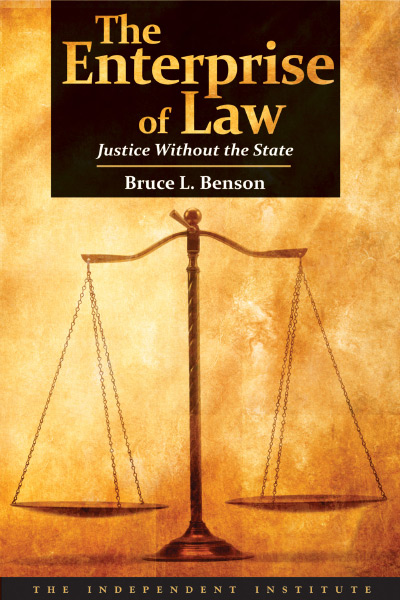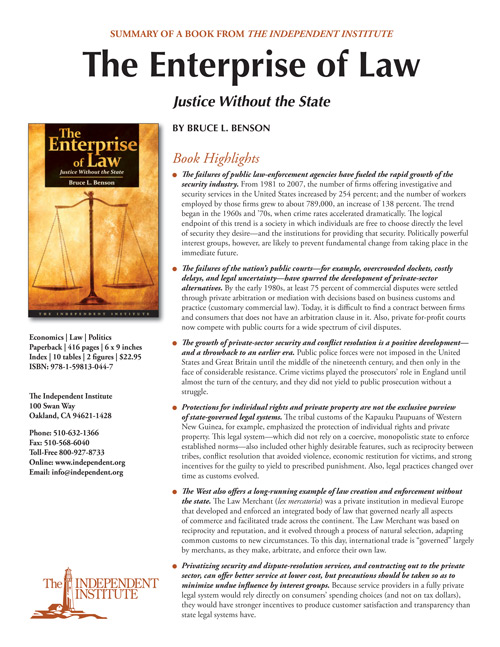Highlights
- The failures of public law-enforcement agencies have fueled the rapid growth of the security industry. From 1981 to 2007, the number of firms offering investigative and security services in the United States increased by 254 percent; and the number of workers employed by those firms grew to about 789,000, an increase of 138 percent. The trend began in the 1960s and ’70s, when crime rates accelerated dramatically. The logical endpoint of this trend is a society in which individuals are free to choose directly the level of security they desire—and the institutions for providing that security. Politically powerful interest groups, however, are likely to prevent fundamental change from taking place in the immediate future.
- The failures of the nation’s public courts—for example, overcrowded dockets, costly delays, and legal uncertainty—have spurred the development of private-sector alternatives. By the early 1980s, at least 75 percent of commercial disputes were settled through private arbitration or mediation with decisions based on business customs and practice (customary commercial law). Today, it is difficult to find a contract between firms and consumers that does not have an arbitration clause in it. Also, private for-profit courts now compete with public courts for a wide spectrum of civil disputes.
- The growth of private-sector security and conflict resolution is a positive development—and a throwback to an earlier era. Public police forces were not imposed in the United States and Great Britain until the middle of the nineteenth century, and then only in the face of considerable resistance. Crime victims played the prosecutors’ role in England until almost the turn of the century, and they did not yield to public prosecution without a struggle.
- Protections for individual rights and private property are not the exclusive purview of state-governed legal systems. The tribal customs of the Kapauku Paupuans of Western New Guinea, for example, emphasized the protection of individual rights and private property. This legal system—which did not rely on a coercive, monopolistic state to enforce established norms—also included other highly desirable features, such as reciprocity between tribes, conflict resolution that avoided violence, economic restitution for victims, and strong incentives for the guilty to yield to prescribed punishment. Also, legal practices changed over time as customs evolved.
- The West also offers a long-running example of law creation and enforcement without the state. The Law Merchant (lex mercatoria) was a private institution in medieval Europe that developed and enforced an integrated body of law that governed nearly all aspects of commerce and facilitated trade across the continent. The Law Merchant was based on reciprocity and reputation, and it evolved through a process of natural selection, adapting common customs to new circumstances. To this day, international trade is “governed” largely by merchants, as they make, arbitrate, and enforce their own law.
- Privatizing security and dispute-resolution services, and contracting out to the private sector, can offer better service at lower cost, but precautions should be taken so as to minimize undue influence by interest groups. Because service providers in a fully private legal system would rely directly on consumers’ spending choices (and not on tax dollars), they would have stronger incentives to produce customer satisfaction and transparency than state legal systems have.
Synopsis
The provision of justice and security has long been linked in most people’s minds to the state. To ask whether non-state institutions could deliver those services on their own, without the aid of coercive taxation and a monopoly franchise, runs the risk of branding one as a naïve anarchist or a dangerous radical. Defenders of the state’s monopoly on lawmaking and law enforcement typically assume that any alternative arrangement would favor the rich at the expense of the poor—or would lead to the collapse of social order and ignite a war of all against all. But how well do these beliefs hold up to scrutiny?
In The Enterprise of Law: Justice Without the State, Bruce L. Benson (Senior Fellow, The Independent Institute; Professor of Economics, Florida State University) offers a powerful rebuttal of the received view of the relationship between law and government. Not only is the state unnecessary for the establishment and enforcement of law, Benson argues, but non-state institutions would also fight crime, resolve disputes, and render justice more effectively than the state because they would have stronger incentives to do so.
Employing economic reasoning and historical analysis, The Enterprise of Law gives readers the background needed to resolve some of the thorniest issues in political and legal theory and offers a multitude of insights that shed light on important aspects of government contracting and privatization. First published in 1990, Benson’s treatise has been reissued with a new preface by the author that explains the book’s growing relevance in the twenty-first century.
“While very few legal and economic scholars considered the idea of justice without the state to be a legitimate research issue in 1990, this is no longer the case,” Benson writes. In fact, much of the academic literature published in the ensuing years has corroborated the book’s findings.
From Voluntary to Authoritarian Law
Lawmaking, courts, and policing are commonly viewed as the exclusive purview of a coercive state, but this was not always the case. Part I begins with a look at examples of customary legal systems with voluntary enforcement—that is, without physical sanctions administered by a coercive authority.
These systems have several things in common. Like the Kapauku Paupuans of Western New Guinea, the Anglo-Saxons before the Norman conquest based their legal traditions on reciprocity, private property, and restitution for injured parties. Anglo-Saxon customary law spelled out the economic penalties for acts of homicide, rape, and other forms of assault; violators who failed to pay restitution lost their right to protection. Similar features characterized the legal customs of medieval Iceland and Ireland; the Law Merchant (a private institution that governed international trade since medieval times); and the western frontier of the United States during the 1800s.
If customary, non-state institutions provided justice effectively, why did authoritarian law replace them? The change occurred at least in part because kings sought to increase their revenues and transfer wealth to politically powerful allies. England’s historical record on public prosecutions, public police, adversarial trials, rules of evidence, and the alienation of crime victims supports this conjecture.
Public Choice and Authoritarian Law
Part II looks at the incentives and constraints of government legal systems. Which factors most influence the outcomes of the state’s provision of justice and law enforcement? Benson focuses on two factors: interest group politics and cost shifting. This potent combination facilitates the passage of laws that otherwise would not get enacted. For example, laws prohibiting “victimless crimes” may be on the books largely because their advocates do not pay the full price of these laws; other people bear much of the costs.
The principle applies broadly. Because the state provides legislatures, courts, and police for “free” (in the sense that users do not usually pay money directly to access their services), overuse and misallocation are the norm, as is typical of common-property resources that are allocated without the use of prices. This “tragedy of the commons” often leads to shortfalls in police staffing, prosecutors’ reliance on plea bargains, the rationing of court time, the rationing of prison space, and the bureaucratic treatment of crime victims.
Another result is corruption. When the justice system is overwhelmed, law-enforcement bureaucrats enjoy greater discretion in allocating limited agency resources among competing demands. Overcriminalization puts police in a position to decide which laws to enforce and which to ignore.
Reemergence of Private Alternatives
Decision-makers in the private sector face different incentives than their public-sector counterparts, and those differences make the private sector more efficient. This advantage helps explain the reemergence of private alternatives in the provision of law and policing, the subject of Part III.
During the 1960s and 1970s, as crime rates rose rapidly, households and firms adopted private means of protection on an unprecedented scale. These tools include alarm systems, safes, automatic phone dialers, window bars, and other protection devices, as well as programs for youth, neighborhood groups, surveillance patrols, private police, private courts, mediation and arbitration, and “rent-a-judge” justice.
Privatization can improve crime prevention, law enforcement, and the courts in several ways: through gains from specialization, efficiency gains in enforcement, and discipline from competition. Benson discusses these benefits in detail and explains why the private sector has stronger incentives to deliver them efficiently than the public sector has.
Incentives, however, are only as “good” as the institutions that shape them; flawed institutions can create bad incentives. Contracting out services to the private sector, for example, can be tricky because the bureaucratic control of lucrative contracts makes the contracting process vulnerable to political corruption. Also, problems associated with the public provision of services may remain because interest groups determine which services are contracted out.
Rationalizing Authoritarian Law
Part IV takes on additional arguments in favor of authoritarian legal systems. Some defenders of authoritarian law claim that private alternatives would be vulnerable to the problem of market failure. Benson devotes an entire chapter to dealing with market-failure arguments as applied to public goods in general, and to policing, courts, and law-making in particular.
In another chapter, Benson rebuts various monopoly arguments for authoritarian law. One argument asserts that a single law-and-order firm would emerge naturally to monopolize the entire industry. Another claims that competition in law and justice would create irreconcilable conflicts. Benson deals with these arguments and with claims that private law would lead to undesirable cost cutting, poor service quality, abuses of power, and favoritism for the rich.
“Some of the arguments against privatization of law and order may have some validity,” Benson concedes, “but the answer to the question of whether or not to privatize must involve an examination of the relative performance of private and public systems of law and order. Neither system will be perfect.”
From Authoritarian to Private Law
Part V begins with a look at the political obstacles to privatizing law and justice. The strongest opposition to dismantling government’s law and its enforcement would come from interest groups with the largest stake in the status quo: public employee unions and associations, bureau managers and other government officials, and certain private sector benefactors of public law and order. Benson shows how each group has resisted previous privatization efforts, and concludes that their political strength makes reductions in the size of the public law-enforcement sector unlikely in the immediate future.
But what would a privatized system of justice and law enforcement look like? Benson makes the case that it would be strongly biased toward individual liberty and private property. Although one can only speculate about the precise features that would develop, he argues, a privatized system would likely have the following general characteristics.
- Payment of full restitution for injured parties—including coverage of the costs to bring an offender to justice—would be a major aspect of punishment for lawbreakers.
- A variety of individual and cooperative arrangements would likely emerge, including insurance-like institutions and “treaties” between competing protection organizations.
- Private courts would reward judges who earn reputations for impartiality and for issuing clear opinions that could be used as a guide to settle future disputes.
- The threat of ostracism and boycott sanctions would help incentivize convicted lawbreakers to pay their debts.
- Prisons would treat inmates well in order to enhance prisoner productivity and hasten the rate of debt repayment.
As noted, the political obstacles to transitioning toward a privatized system are daunting, but Benson is optimistic that potential benefits of doing so will entice many readers to carefully investigate the ideas examined in The Enterprise of Law.
“I hope that the arguments presented in this book are sufficiently strong to convince readers that relying on customary law and private sector provision of law enforcement is not ‘outlandish’ or ‘frightening,’” Benson writes. “Many questions might remain, of course, even for those who find the arguments for privatization to be compelling.”








